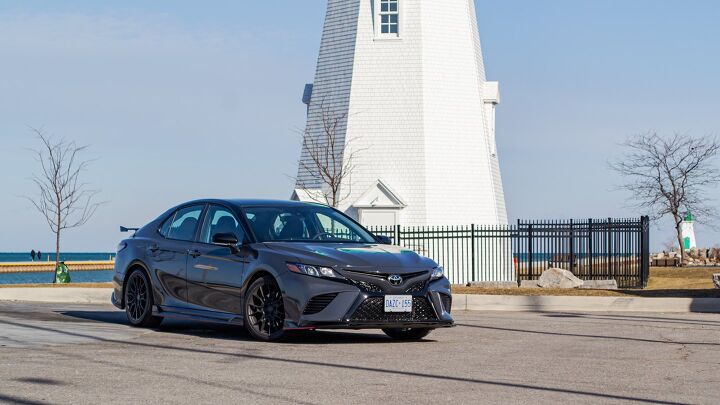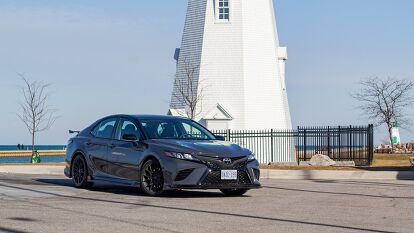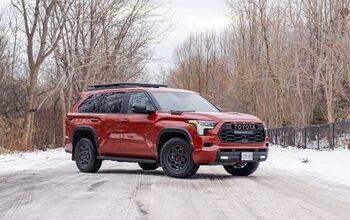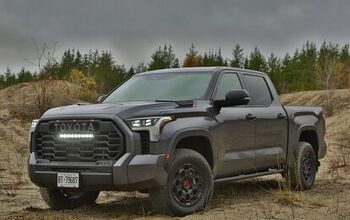2024 Toyota Camry TRD Review: The Last of Us

Love It | Leave It |
|---|---|
V6 sound | Bad transmission |
Good driving balance | Dated infotainment |
Superb value | Lacks features of competitors |
Should we celebrate something simply because it’s the last of its kind?
This is the question that I ask myself multiple times behind the wheel of the 2024 Toyota Camry TRD. The final mainstream, naturally-aspirated V6-powered sedan is about to roll off into the sunset; its replacement will be hybrid-only. A breed that once dominated the roads of the US and Canada, going the way of personal luxury coupes and manual-transmission supercars.
From a practical perspective, this all makes sense, and I’m sure the vast majority of existing and future buyers will be just fine with standard gas savings. Yet for a small sub-section of buyers, the TRD offers an extra dose of fun in an otherwise extremely practical package. It’s the least rational Camry, and that sort of oxymoron is catnip to car folks.
What’s new?
Pretty much zilch since we first drove the Toyota Racing Development model way back in the summer of 2020. The whole Camry family saw a subtle facelift a year later, but since then it’s been more or less coasting. The TRD has stuck to its guns as the most affordable six-cylinder Camry, offering buyers the combo of five-seat comfort along with 301 horsepower and 267 pound-feet of torque. That all comes in at around $35,000 ($40,000 CAD); a lot of car for the money.
While the four-cylinder Camry can be had with all-wheel drive, and the ’25 will add that option to the hybrid powertrain as well, the V6 remains a front-axle-only affair. An eight-speed automatic continues to be the only transmission available.
For 2024, buyers have nothing but monochrome paint options, though the Wind Chill Pearl and this Underground bring a contrasting black roof for an extra bit of cash. It’s still a handsome car to these eyes, the TRD skirts adding a bit of aggression, and the trunk spoiler a whole lot of it. The 19-inch alloys still look sweet, even if it’s a bit like seeing Dunks on dad.
Mixed emotions
Our reunion is off to a good start: I pick the Camry up late at night, where the cold start of the V6 is almost more welcome than the fast-acting seat heaters. (Sorry, the latter is a Canada-only feature for the TRD.) There’s just enough muscle to the soundtrack to remind the driver of the red badge on the trunk, but not enough to draw undue attention or wake the neighbors. Wind the 3.5 out and it’s a crisper howl than any turbo-four. No wonder Lotus stuck this in the middle of its cars for a decade.
Okay, winding the engine out is harder than it seems. For reasons unknown, Toyota’s eight-speed doesn’t respond to pulls of the paddles or sport mode like most other ‘boxes. The gear indicator is more accurately a range: you’re not sticking to fourth gear, you’re telling the ECU it can only pick from the first four cogs. It’s a frustrating situation with no real workaround.
That’s still a shame, because the TRD is good old-school fun, even on winter rubber. The steering is light on feedback and resistance, but in that modern TNGA platform way, it’s always accurate and fairly quick lock-to-lock. The Camry has resisted putting on too many pounds the last 20 years, so it’s eager to turn in, and that long wheelbase keeps it feeling secure through directional changes. The TRD-tweaked ride is stiffer than any other Toyota this side of a GR badge, but it’s hardly unreasonable. Last but not least, the brake pedal is strong and progressive.
Same spacious sedan
The Camry cabin is a mix of practical use with bit of design flair. The S-bend that dominates the dashboard design looks a little dated against today’s rectilinear trends, and the expanse of piano black is tough to keep clean. The climate controls require zero thought to use without looking however, and that arguably matters more. The door and center console storage spaces are ample, though larger cups can be a tight fit in the front-most cupholder. Cabin materials all feel up to par for the class, with exception to the fiddly little seat heater controls aft of said cupholders. TRD dressing includes red stitching everywhere—including the headrests—and the dails now fully bathed in the hue. Hope you don’t need to look at your speedo in direct sunlight, polarized sunglass wearers.
The Camry remains a thoroughly spacious sedan, only bested by the enormous Honda Accord. The lack of sunroof makes for solid headroom up front, and the important measures are square for the second row: 38.0 inches (965 millimeters) for noggins and knees. Trunk space is 15.1 cubic feet (428 liters), though keep in mind the TRD does not have fold-down seats. It also has large swan-neck hinges, so be careful filling the trunk with anything fragile.
Wayback playback
There’s only one way Toyota could sell this TRD for less than any other V6: de-contenting. That’s why it’s the only six-cylinder without dual-zone climate control or moonroof. Say goodbye to rear-seat USB ports or a wireless charger, too.
As perhaps the most damning example of just how far the Camry has fallen down the priority ladder at Toyota, it still rolls around with a 7.0-inch touchscreen running Entune. The screen is low-res and slow to respond, but on the flip-side, it’s silly easy to use. A USB-A port for wired Apple CarPlay almost feels quaint, but that too is unflappable. And hey, a physical home button to get to the main menu is something the new system doesn’t even have…
At least the standard safety and driver assist lineup is modern. Toyota Safety Sense 2.5 includes full-range adaptive cruise control, automated emergency braking, blind spot monitoring, rear cross-traffic alert, and road sign assist. Auto high beams are included, though the Camry’s Bi-LED combination lights are only okay in the dark.
Dollars and sense
The no-nonsense approach extends to the Camry TRD’s pricing. In America it lists for $34,580 including destination. Beyond the premium paints, the only cost option is the premium audio upgrade ($1,585). Buyers can pick from all-season or summer rubber at no cost.
Canada is much the same story, though the audio upgrade is off the table. The sticker is $40,160 CAD including destination, for an as-tested price of $40,700 CAD for our Underground tester.
Verdict: 2024 Toyota Camry TRD Review
Objectively, the 2024 Toyota Camry TRD is not a great car. It foregoes plenty of modern creature comforts for the sake of minor performance tweaks, and is hobbled by its dimwitted transmission. A Hyundai Sonata N Line or Kia K5 GT would offer similar scrappy front-drive fun, with more modern creature comforts for barely more money.
Does the V6 make up for that? Probably not, but I appreciate that Toyota stuck to the formula for as long as it did. Maybe that’s something worth celebrating after all.
Become an AutoGuide insider. Get the latest from the automotive world first by subscribing to our newsletter here.
Category | 2024 Toyota Camry TRD |
|---|---|
Powertrain | 7 / 10 |
Efficiency | 8 / 10 |
Handling and Drivability | 8 / 10 |
Passenger Comfort | 7 / 10 |
Ride Quality | 4 / 5 |
Exterior Style | 4 / 5 |
Interior Style and Quality | 7 / 10 |
Infotainment | 6 / 10 |
Cargo/Towing | 3 / 5 |
Safety | 3 / 5 |
Value | 8 / 10 |
Emotional Appeal | 8 / 10 |
Total | 73 / 100 |
2024 Toyota Camry TRD | |
|---|---|
Engine: | 3.5L V6 |
Output: | 301 hp, 267 lb-ft |
Transmission: | 8AT, FWD |
US Fuel Economy (MPG): | 22/31/25 |
CAN Fuel Economy (L/100 km): | 10.7/7.4/9.2 |
Starting Price (USD): | $34,580 (inc. destination) |
As-Tested Price (USD): | $35,080 (inc. destination) |
Starting Price (CAD): | $40,160 (inc. destination) |
As-Tested Price (CAD): | $40,700 (inc. destination) |

Kyle began his automotive obsession before he even started school, courtesy of a remote control Porsche and various LEGO sets. He later studied advertising and graphic design at Humber College, which led him to writing about cars (both real and digital). He is now a proud member of the Automobile Journalists Association of Canada (AJAC), where he was the Journalist of the Year runner-up for 2021.
More by Kyle Patrick



































































Comments
Join the conversation